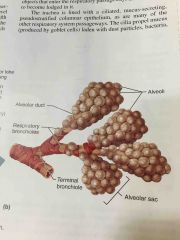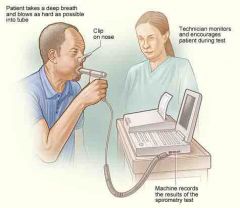![]()
![]()
![]()
Use LEFT and RIGHT arrow keys to navigate between flashcards;
Use UP and DOWN arrow keys to flip the card;
H to show hint;
A reads text to speech;
44 Cards in this Set
- Front
- Back
|
upper respiratory system consists of |
nose, nasal cavity, pharynx, and associated structures |
|
|
lower respiratory system consists of: |
larynx, trachea, bronchi, lungs |
|
|
conducting zone includes |
nose, nasal cavity, pharynx, larynx is, trachea, bronchi, bronchioles, terminal bronchioles |
|
|
function of the conducting zone |
to filter, warm, moisten air as it enters lungs |
|
|
respiratory zone: |

where gas exchange occurs, includes bronchioles, alveolar ducts, alveolar sacs, alveoli |
|
|
external nose contains: |
bony framework, mucus membranes, cartilage, covered with muscle and skin |
|
|
internal nose contains: |

1.nasal cavity containing three nasal conchae 2.four pairs of paranasal sinuses 3.upper "respiratory" region of internal nose contains goblet cells and cila 4.lower "olfactory" region contains olfactory receptors |
|
|
pharynx location: |
1.anterior to the cervical spine 2.superior to larynx 3.posterior to nasal and oral cavity |
|
|
Three regions of the pharynx: |
nasopharynx
oropharynx
laryngopharynx |
|
|
pharynx will turn into: |
esophagus and will then travel to the stomach |
|
|
larynx location: |

anterior to esophagus at approximately C4-C6 level |
|
|
The walls all of the larynx include: |
9 pieces of cartilage, intrinsic and extrinsic muscles |
|
|
structures found on the anterior larynx: |
1)thyroid cartilage: aka Adam's apple (FYI Thyrohyoid membrane connects thyroid cartilage to hyoid bone) 2)cricoid cartilage: forms the inferior wall of the larynx(FYI cricotracheal ligament attaches cricoid cartilage to 1st ring of trachea) 3)epiglottis: "trap door" covers the vocal chords and prevents food from entering wrong tube |
|
|
structures found on the posterior larynx: |
1)arytenoid cartilage: triangular cartilage 2)Corniculate Cartlidge: the little "horn" 3)cuneiform cartilages: club shaped cartilage |
|
|
structures of voice production: |
1-vocal chords:The superior "vestibular fold" and the inferior "vocal fold" 2-rima vestibule: The space between the vocal chords 3-laryngeal sinus: the lateral space between vocal folds 4-additional structures that support voice |
|
|
functions of respiratory system: |
Exchange of gases
Adjust pH of body fluids |
|
|
functions of internal nose |
filter, warm, and Moisten air
detect olfactory stimuli
resonance for speech vibration |
|
|
function of the pharynx |
food passageway
resonance for sound/speech
houses tonsils |
|
|
function of the epiglottis of the larynx |
act as trapdoor to protect vocal chords and prevent food passage |
|
|
function of the cuneiform cartilages of the larynx |
support the vocal cords and the lateral aspect of epiglottis |
|
|
function of mucous membranes (aka vocal chords) |
Voice production
holding the breath |
|
|
function of trachea |
passageway for air |
|
|
function of trachealis muscle |
allow diameter to trachea to change with breathing |
|
|
function of Pleura of lungs |
natural protective mechanism of lungs to allow appropriate surface tension |
|
|
pulmonary ventilation |
The process of gas exchange (pulmonary respiration) |
|
|
three steps of pulmonary respiration: |
1-breathing by inhaling and exhaling(pulmonary respiration)
2-Exchange of gas to remove CO2 waste and obtain O2( pulmonary ventilation)
3-bringing O2 to the capillaries of tissues( tissue respiration) |
|
|
The effort required to breathe can be altered by: |
airflow obstruction,
alveolar Service tension,
lung compliance/quality |
|
|
Lung volume and capacities: |
1.in average healthy adult takes 12 breaths per minute
2.The tidal volume is the amount of air you can take in during one breath 3.when circulated, totals an average of 6 L of air per minute 4.70% of the title volume will reach the aveoli level |
|
|
oxygen transport: |
1.oxygen to not dissolve in water therefore It cannot travel alone and blood 2.to make that happen heme is required 3.heme what is the part of our red blood cells that's the oxygen carrying red protein 4.heme contains iron which binds to oxygen and transports it |
|
|
oxygen transport: |
1.oxygen to not dissolve in water therefore It cannot travel alone and blood 2.to make that happen heme is required 3.heme what is the part of our red blood cells that's the oxygen carrying red protein 4.heme contains iron which binds to oxygen and transports it |
|
|
carbon dioxide transport: |
1.most often travels by biocarbonate ions
2.could also travel by carbamino compounds
3.could also travel by CO2 disillusion
FYI ... if less O2 is attached to the hemoglobin there is more room available for CO2 to be carried out |
|
|
Control of respiration: |
1.The respiratory center of the medulla and pons in the brain has three subdivisions that involuntarily control breathing 2.all "Standard" parts of a feedback loop apply 3.can be influenced by our emotions, voluntary actions, temperature, blood pressure |
|
|
what is a spirometer? |

Machine that measures how much air is EXHALED! |
|
|
The exchange and transport of gasses: |
each gas acts independently...and if the pressure of gas is increased and the amount absorbed by blood will increase as well |
|
|
what are the two further divisions of gas exchange: |
1.pulmonary gas exchange which occurs at the Alveoli level in lungs
2.systemic gas exchange which occurs at the capillary level in the tissues
|
|
|
inhalation Key points: |
1.primary muscle of inspiration is the diaphragm 2. to inhale..lungs must vertically expand and the diaphragm must drop 3.for the Lungs to fill the pressure must be decreased (boyles law) muscle contraction required to inhale is an active process
|
|
|
inhalation Key points: |
1.primary muscle of inspiration is the diaphragm 2. to inhale..lungs must vertically expand and the diaphragm must drop 3.for the Lungs to fill the pressure must be decreased (boyles law) muscle contraction required to inhale is an active process
|
|
|
inhalation Key points: |
1.primary muscle of inspiration is the diaphragm 2. to inhale..lungs must vertically expand and the diaphragm must drop 3.for the Lungs to fill the pressure must be decreased (boyles law) muscle contraction required to inhale is an active process 4.pregnancy, obesity could affect inhalation
|
|
|
inhalation Key points: |
1.primary muscle of inspiration is the diaphragm 2. to inhale..lungs must vertically expand and the diaphragm must drop 3.for the Lungs to fill the pressure must be decreased (boyles law) muscle contraction required to inhale is an active process 4.pregnancy, obesity could affect inhalation 5.secondary muscles are the external intercostals |
|
|
inhalation Key points: |
1.primary muscle of inspiration is the diaphragm 2. to inhale..lungs must vertically expand and the diaphragm must drop 3.for the Lungs to fill the pressure must be decreased (boyles law) muscle contraction required to inhale is an active process 4.pregnancy, obesity could affect inhalation 5.secondary muscles of inspiration are the external intercostals |
|
|
inhalation Key points: |
1.primary muscle of inspiration is the diaphragm 2. to inhale..lungs must vertically expand and the diaphragm must drop 3.for the Lungs to fill the pressure must be decreased (boyles law) muscle contraction required to inhale is an active process 4.pregnancy, obesity could affect inhalation 5.secondary muscles of inspiration are the external intercostals |
|
|
important trachea information: |
1.extends the larynx and separates at approximately T5 level into the primary bronchi
2.layers of the tracheal wall from deepest to most superficial include: mucosa , submucosa, secodary bronchus, tertiary bronchus, terminal bronchioles
3.proximately 20 C shaped Rings
|
|
|
trachea information part two: |
4.divisions after the carina our primary bronchus, secondary bronchus, tertiary bronchus, terminal bronchioles
5.clara cells in the terminal bronchioles protect against carcinogens and toxins when inhaled |
|
|
lung information |
1.bilateral cone shaped organs 2.has a mediastinal surface and a costal service 3.right lung has:superior lobe, horizontal Fissure, middle lobe, oblique fissure 4.left lung has:superior lobe, oblique fissure, inferior lobe 5.has parietal pleura and visceral pleura which creates a space between the cavity and surface tension |

